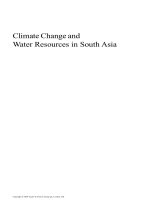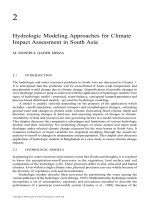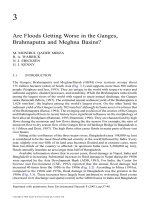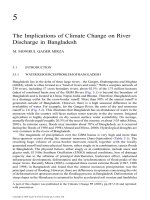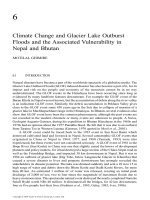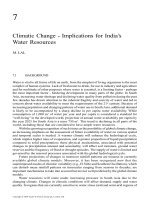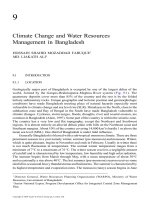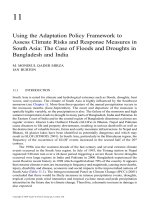Climate Change and Global Food Security - Section 5 doc
Bạn đang xem bản rút gọn của tài liệu. Xem và tải ngay bản đầy đủ của tài liệu tại đây (529.07 KB, 84 trang )
Section V
Policy and Economic Issues
© 2005 by Taylor & Francis Group, LLC
641
26
Policy and Economic Issues Dealing
with Global Warming
G. EDWARD SCHUH
CONTENTS
26.1 Global Warming as an International Policy Issue 642
26.2 An Optimal Degree of Global Warming? 644
26.3 Toward International Cooperation 645
26.3.1 The Kyoto Treaty as a Starting Point 645
26.3.2 The Broader Policy Perspective 646
26.3.3 Food Security 647
26.3.4 Geographic Variability 649
26.4 A New Policy Perspective 650
26.4.1 Strengthening the Knowledge Base 650
26.4.2 Strengthening Global Institutional
Arrangements 651
26.4.3 Devising an Effective Incentive System 652
26.5 The Potential for Disciplinary Synergism 653
26.6 Concluding Comments 654
© 2005 by Taylor & Francis Group, LLC
642 Schuh
Acknowledgments 655
References 655
Debates about global warming have tended to be rather
intense. The contributions to this volume have, however,
moved beyond the rather frustrating debates about causes of
global warming, and have sought instead to improve our
understanding of such issues as the consequences of any
warming for agricultural and terrestrial productivity, the
potential contributions of carbon sequestration to reducing
global warming, and the effects of mitigation efforts expected
at the farm level. We are offered a cornucopia of scientific
analyses and evidence on these issues, together with some
constructive debate.
It is important to address the policy and economic dimen-
sions of this subject. Both aspects have received too little
attention in the discussions of global warming. It is true that
some of the economic costs and implications have received
attention in recent years (see, e.g., Nordhaus, 1994), but eco-
nomic policy issues have still received only limited attention.
Technological solutions to the problem have also received
some attention, as evidenced in the contributions to this vol-
ume, but even then, the range of alternatives considered has
been rather limited.
This chapter has three main focuses: (1) global warming
as an international policy issue, with important implications;
(2) some optimal degree of warming or temperature change
as a matter for policy analysis; and (3) international cooper-
ation in a world of uneven scientific capability, uneven insti-
tutional development, and uneven impacts from projected
global changes. This discussion will lead to certain conclusions
for policy consideration.
26.1 GLOBAL WARMING AS AN
INTERNATIONAL POLICY ISSUE
We should begin by noting that global warming is, by defini-
tion, a global problem. Because it extends beyond national
© 2005 by Taylor & Francis Group, LLC
Policy and Economic Issues Dealing with Global Warming 643
boundaries, it must be addressed by global policy measures.
The fashioning and implementation of global policy measures
is a novel challenge in that it implies the need for creating
international public goods. Public goods are in general pro-
vided by governments, yet at the international level there is
no government.
This is a long-standing problem in foreign affairs and
international relations. When addressing this issue some
years ago, Kindleberger (1986) proposed that in general, the
problem can be solved by two means. The first is for the
reigning hegemonic power to provide the appropriate public
good. The United Kingdom did this for the international econ-
omy during much of the 19th century. Similarly, in the second
half of the 20th century the United States provided monetary
stability for the global economy by serving as central banker
for the world, and sustaining an effective dollar standard for
the international trade and financial system.
An alternative approach is what Kindleberger referred
to as the “realist” solution, where groups of countries agree
to come together to form institutional arrangements that pro-
vide the needed public good or goods. There are currently a
number of such arrangements on the international scene,
perhaps the most significant at this point being the World
Trade Organization (WTO).
The origins of the WTO are to be found in the General
Agreement on Tariffs and Trade (GATT), a rather modest
framework of rules governing international economic rela-
tions established in 1947 after the U.S. Senate failed to ratify
the treaty creating the more ambitious International Trade
Organization. There are many lessons derivable from the
GATT and its evolution into the WTO. In the first place,
membership is strictly voluntary. Neither the GATT nor the
WTO had (have) an army, navy, or air force. The successive
organizations have negotiated the rules for international
trade, and member states have agreed to follow them. More-
over, from a modest group of industrialized countries that
agreed to negotiate reductions in tariffs on manufactured
products, the scope of trade issues subject to negotiation by
© 2005 by Taylor & Francis Group, LLC
644 Schuh
the WTO has increased significantly, and membership has
grown to over 180 countries.
The Kyoto Treaty was a “realist” attempt to find a work-
able solution to the global warming problem. (The Montreal
Treaty for dealing with the problem of atmospheric ozone
change was a predecessor.) The withdrawal of the United
States from the Kyoto Treaty may have delivered it a fatal
blow, especially if Russia follows the U.S. lead in withdrawing
its support.
It may be that the drafters of the Kyoto Treaty were too
ambitious. A more modest beginning might have made success
more likely. The modest initial beginnings of the GATT may
provide some important lessons. I will return to this issue later.
26.2 AN OPTIMAL DEGREE OF GLOBAL
WARMING?
Global warming issues are hard to resolve, in part because
their discussion is so open-ended. Contemporary discussions
have concentrated on ways to mitigate or reduce global warm-
ing, rather than looking beyond those objectives. In the pre-
vailing estimates of the costs and benefits of global warming,
there is an implicit assumption that there is some optimal
degree of global warming, or some optimal temperature for
the Earth, and that there is only one direction to move in
attaining it — to mitigate or stop the current trend. However,
do we really know what this temperature is?
R. Lal has implied that identifying an optimal degree of
warming is possible when he noted that average global tem-
perature has ranged between −18° C to +15°C. That is quite
a wide range, and if there are costs and benefits in going from
one average temperature to another, then there must be an
optimal temperature for the Earth — something that C.
Rosenzweig referred to, when commenting on my proposition,
as a stabilization level.
Certainly, if one is willing to commit significant public
and private resources to affect the global temperature, then
why should those resources not be committed to moving the
world toward what would be an optimal temperature? In fact,
© 2005 by Taylor & Francis Group, LLC
Policy and Economic Issues Dealing with Global Warming 645
when establishing quotas and other targets for policies
designed to affect global warming, some target temperature
would seem to be an imperative. Is it appropriate to expend
resources to mitigate or reduce global warming when we have
no notion of the ultimate goal?
I would argue that it makes no sense to insist on miti-
gating policies without having some notion of the ultimate
target. The failure to establish such an optimal temperature
follows from the tendency in much of the discussions of global
warming to ignore people — similar to the approach by many
environmentalists. Yet surely, if Nordhaus can estimate the
costs and benefits of global warming, we can move beyond
those calculations to ascertain some optimal temperature for
the Earth.
It may be helpful to introduce the concept of an optimal
global temperature as we address these problems, even if we
currently lack the data to estimate the optimum as a practical
matter. First, it would focus our attention on assembling the
necessary data and undertaking the appropriate analyses to
arrive at such a conclusion, which should give us a better
understanding of all the important issues involved. Second,
it would help us avoid committing massive resources in what
could turn out to be misguided directions.
26.3 TOWARD INTERNATIONAL
COOPERATION
Consideration of the broader discussion of policy issues
related to global climate change and of measures to modify
this can usefully begin with a look at the Kyoto Treaty. We
also need, however, to adopt a broader policy perspective, to
address food security issues, the fact of variation in climatic
conditions, and the institutional capability to address global
warming problems. A discussion of these issues follows.
26.3.1 The Kyoto Treaty as a Starting Point
The United States has a great deal to offer to global society
by rejoining the efforts to implement the Kyoto Treaty, and
© 2005 by Taylor & Francis Group, LLC
646 Schuh
by recommitting to the objectives of that treaty. The United
States has substantial scientific, technological, and analytical
capability needed to address these issues. We could use these
resources to help identify the optimal acceptable degree of
global warming. Such a concept should guide the Kyoto Treaty
initiative. However, we also might scale down the scope of
this initiative, and focus it on a more modest set of objectives
that would help mobilize the political support for what is
proposed. The beginnings of the GATT/WTO serve as an
attractive precedent.
Americans are rightly concerned about their national
security. That national security is ultimately rooted in our
economic security. We can add to our economic security by
deploying our considerable economic power to strengthen
international institutions. That power should be deployed in
support of international cooperation with national and inter-
national organizations and institutions.
26.3.2 The Broader Policy Perspective
Implementation of the Kyoto Treaty should take place within
the context of a broader perspective on the evolution of inter-
national policy institutions. Rapid and significant initiatives
are taking place in this broader context. Globalization, for
example, is causing economic policymaking and implementa-
tion to be increasingly beyond the reach of national economic
policymakers. The loss of national sovereignty over economic
policy is the source of much contemporary concern in this
country, as it is elsewhere.
When policymaking and implementation move beyond
the reach of national economic policy, a process of bifurcation
follows. Some part of economic policymaking and implemen-
tation shifts up to the international level and becomes embed-
ded in international organizations and institutions. Another
part shifts down to the state and local level and becomes
embedded in organizations and institutions at that level.
The policy milieu is currently in a rapid state of flux as
shifts occur as to where policymaking and implementation
take place. Reform is needed at all levels of the process if we
© 2005 by Taylor & Francis Group, LLC
Policy and Economic Issues Dealing with Global Warming 647
are to make efficient use of our resources and provide for an
equitable distribution of income (Schuh, 2003). This provides
an opportunity to do the institutional design needed at each
level to address global warming. In addition to the design
work that is a policy imperative, there is much analytical
work to be done in sorting out the problems unique to the
international, national, and state and local levels. That anal-
ysis has to be the starting point for the institutional work.
26.3.3 Food Security
World food security is a concern in many contributions to this
volume, some focused at the local level, and some at the
national level. This concern incorporates the “people” dimen-
sion into discussion of problems usually framed in biophysical
terms. However, I would note that many if not most of these
presentations regard the essence of the food security problem
as a matter of production. We learned long ago that famine
and malnutrition are mainly results of poverty, rather than
production shortfalls per se. In fact, Sen’s famous analysis
(1981) of the classic famines of China and India showed that
during the most dire part of the famines, local food prices
actually declined. Demand dropped under desperate circum-
stances, so that those with purchasing power could get food
more cheaply — but most lacked purchasing power.
This observation in no way diminishes the importance of
agricultural modernization and its contribution to alleviating
poverty. However, it does provide an important perspective on
how such modernization contributes to poverty alleviation.
The contribution occurs through broad-based increases in con-
sumers’ real incomes rather than through an effect on pro-
ducers as is commonly assumed. That becomes clear once one
takes into consideration the general equilibrium effects of
agricultural modernization (Schuh 1999).
Understanding the contribution of agricultural modern-
ization to poverty alleviation in society directs increased
attention to rural development. The modernization of agricul-
ture makes it almost inevitable that much rural labor has to
leave the agriculture sector if the per capita income of that
© 2005 by Taylor & Francis Group, LLC
648 Schuh
labor is to keep pace with that in the nonfarm sector. That
makes the exit of labor from agriculture a measure of policy
success, assuming that such movement results from the “pull”
of urban opportunity rather than the “push” of rural immis-
eration.
Because gainful employment outside of agriculture typ-
ically entails migration to alternative employment at long
distances, the labor market becomes very imperfect, with wide
disparities in wages for quality-equivalent labor. One way of
promoting mobility is to promote expansion of nonfarm
employment in rural areas, which is understood by the term
“rural development.” Ironically, the natural process of selec-
tion of migration and most of the policy measures imple-
mented to promote economic development operate on the
opposite development. The process of migration is highly
selective of human capital, and thus drains this most impor-
tant resource from the part of the economy where it is much
needed. Similarly, policy measures tend to concentrate on
subsidies for the expansion of the nonfarm sector in urban
areas. This has the effect of imposing negative externalities
in both the supplying and receiving region.
Our consideration of how different measures can deal
most effectively with the challenge of global warming to food
security would have benefited from more serious consider-
ation of rural development policies. No matter what is done
about climate change itself, we need to design more effective
institutional arrangements that will not just mobilize the
agricultural surplus generated by agricultural modernization,
but will use it to generate an expansion of nonfarm activities
in rural areas.
Much of the discussion of agricultural modernization has
appeared misguided, as it has focused on raising the produc-
tivity of land — for instance, this perspective underlaid the
Green Revolution in Asia. However, raising the productivity
of land may contribute little to raising labor productivity, and
this is what is critical to increasing the per capita incomes of
rural people.
Hayami and Ruttan (1985) made the important point
long ago that the adoption of new technology follows the
© 2005 by Taylor & Francis Group, LLC
Policy and Economic Issues Dealing with Global Warming 649
relative resource scarcity prevailing in the agricultural sector.
In land-scarce Japan, the beginning of technological progress
was built on technological innovations that enhanced land
productivity, the most limiting factor. Conversely, in labor-
scarce United States, the process was the opposite, with labor
productivity-enhancing technological innovations emphasized
in the beginning. Moreover, later when the conditions of
resource scarcity reversed themselves, the processes of tech-
nological innovation reversed themselves in both countries.
That analysis, supported by extensive empirical evidence,
implies that the subproduction functions underlying the land
and labor sides of the basic production functions are separa-
ble. What happens on one side of the production function is
largely independent of the other.
The work of Hayami and Ruttan has provided important
guidance to policymakers all around the world. It is sad that
both policymakers and policy analysts have ignored this cen-
tral part of their analysis. In Sub-Saharan Africa in particu-
lar, labor is the relatively scarce resource. Policy needs to be
directed to raising labor productivity at this stage of economic
development, not primarily to raising land productivity.
To conclude this section, I should underscore the need
for greater emphasis on rural development and a more
rational science and technology policy if the productivity and
the per capita incomes of rural people are to be raised and
their food security problem addressed. Increases in per capita
income are critical to addressing the food security problem,
as most of the poverty in the developing countries is found in
rural areas.
26.3.4 Geographic Variability
The impacts of global warming will vary a great deal from
one region to another. That means that the policies appropri-
ate for one region may not be appropriate for another. Simi-
larly, the institutional arrangements available for addressing
the problems of global warming will also vary a great deal.
This includes the capability of markets to perform efficiently,
and thus the efficiency and effectiveness with which markets
© 2005 by Taylor & Francis Group, LLC
650 Schuh
can bring resources to bear on the problem. In the developed
Organization for Economic Cooperation and Development
(OECD) countries, for the most part the institutional arrange-
ments available to address global warming problems are more
than adequate, although the political processes for consolidat-
ing constructive action may have less capability. In both
domains, the capability in many developing countries is less
than what is expected to be necessary for effective action in
the face of climatic difficulties.
26.4 A NEW POLICY PERSPECTIVE
The world continues to drift along with growing evidence that
global warming is a fact, even though we do not fully under-
stand what is causing that warming. Moreover, it has been
difficult to mobilize globally the political support to do any-
thing about it. For the most part, we rely on the volunteer
efforts of national governments to take whatever steps they
can find political support for. The Koyoto Protocol was
designed to move us one step further toward collective action,
but the reticence of the United States and other countries to
collaborate effectively has resulted in stalled efforts.
Revitalizing efforts toward more effectively managing
the process of climate change would benefit from three actions
or initiatives at the international level: (1) a stronger knowl-
edge base, (2) a stronger global institutional capability, and
(3) an incentive system that rewards nations and their citi-
zens for participating in something along the lines of the
Koyoto Protocol.
26.4.1 Strengthening the Knowledge Base
The lack of knowledge on important issues becomes obvious
as one participates in debates surrounding global warming. A
number of priorities quickly emerge. The first, and perhaps
most fundamental and glaring, is the lack of a consensus
among scientists on the underlying causes behind the
observed changes in global temperatures. We know that his-
torically these temperatures have experienced both short-term
© 2005 by Taylor & Francis Group, LLC
Policy and Economic Issues Dealing with Global Warming 651
fluctuations and longer-term trends. Despite the substantial
additions to our knowledge, there continues to be a great deal
of uncertainty about the underlying causes that are driving
those changes.
Having a better understanding of the causal factors
behind global warming is fundamental to designing policy
responses to this phenomenon. If the cause is anthropomor-
phic, and this is where a significant part of the lack of agree-
ment centers, some of the remedies are obvious. If instead it
is not anthropomorphic, but due to physical phenomena in
the larger environment, some of the same policy recommen-
dations may apply, while others may not.
Understanding the underlying causes of global changes
in temperature is also important if serious attempts are to be
made to calculate an optimal temperature or stabilization
value for the global temperature. Such knowledge will be
especially important once one recognizes the need to reflect
regional differences in such calculations.
Knowledge is also important if “quotas” are ultimately
assigned to individual countries for changes in their contri-
butions to global temperature changes. That knowledge will
be critical to estimating the marginal benefits and the mar-
ginal costs of remedial efforts for individual countries. Ulti-
mately, such allocations are needed. Moreover, knowledge of
the marginal benefits and costs of individual policy actions is
needed if rational policies and their associated institutional
arrangements are to be designed.
26.4.2 Strengthening Global Institutional
Arrangements
As noted above, the institutional capacity to deal with global
temperatures varies a great deal from country to country. For
the most part, OECD countries have an adequate capacity
not only to identify the problem, but also to design and imple-
ment policy responses to it. At the same time, most of the
developing countries are sorely deficient in their institutional
capacity. Similarly, institutional capacity is also sorely limited
at the international level, especially if we should be able to
© 2005 by Taylor & Francis Group, LLC
652 Schuh
design incentive arrangements that will make national par-
ticipation viable on a broad scale.
Perhaps the most effective way to deal with the deficien-
cies in the developing countries is by way of scientific and
technological cooperation. If those efforts are directed to
strengthening scientific and technological capacity in the
developing countries, both the developed and developing coun-
tries that collaborate will benefit. Both sides will benefit from
the new knowledge they generate in the process of cooperat-
ing. They will also benefit from the investments they make
in their own human capital by collaborating on the research.
The exchange of faculty and students will be a critical feature
of such cooperation.
The variability of conditions and of capabilities to
address the consensus building and operational problems
poses a major problem because of the existing complexity.
Having a wide variety of approaches to solving the problem
should be accepted and embraced. Helping to develop local
capabilities to address the problem and to design institutional
arrangements for solving the problem presents a major oppor-
tunity for international cooperation. To the extent that such
cooperation makes it possible to find more rapid and efficient
solutions to the problem, this may help to mobilize political
support for an international solution to the problem.
26.4.3 Devising an Effective Incentive System
The goals of public policy are frequently articulated as (1)
efficiency, (2) equity, and (3) security. Briefly, efficiency refers
to making rational use of available resources so that both
individual countries and the global economy grow at the opti-
mal rate. Equity refers to obtaining a distribution of income
consistent with what the body politic desires. And security
refers to an absence of, or minimal exposure to, risk and
uncertainty.
A major problem with the Kyoto Protocol is that there are
no incentives for national governments or policymakers to par-
ticipate. Whether governments participate or not is strictly a
voluntary issue. That, in turn, depends on the degree of political
© 2005 by Taylor & Francis Group, LLC
Policy and Economic Issues Dealing with Global Warming 653
support and consensus that they can generate to mobilize sup-
port for what can in some cases be painful processes.
If there is to be progress in addressing the issue of global
temperature change, it seems likely that there will have to
be incentives for policymakers and national governments to
participate and comply with what is mutually agreed upon.
This is an area in which more creativity is needed. To offer
one speculative suggestion on the possibility for incentives, it
would seem that one could obtain a fruitful cooperation and
linkage between the issues of global warming and interna-
tional trade. In principle, the idea would be to link progress
in dealing with the global temperature problem with potential
benefits from trade.
This is not the occasion to sketch out in full detail what
such a system might look like. However, it would seem that
the critical component would be a means of linking perfor-
mance on environmental modification with potential benefits
from trade liberalization. The tarrification of all barriers to
trade that was associated with the establishment of the WTO
would seem to be an observable parameter with which one
could work. The problem would be to have an institutional
mechanism for granting trade liberalization for individual
countries as the means to reward sound performance in reduc-
ing greenhouse gases, together with a means of enforcing it.
The obvious choice would be the WTO, but whether that
organization can be credible in such a situation is question-
able. An alternative would be to create a new international
institution specifically to broker such negotiations. Finally,
there is the possibility that the OECD countries could muster
sufficient political will and commitment to provide the lead-
ership for brokering such arrangements.
26.5 THE POTENTIAL FOR DISCIPLINARY
SYNERGISM
This volume provides an example of the potential synergism
from interdisciplinary collaboration in research on global
warming. Given the degree of disciplinary specialization that
prevails in academic circles, it is difficult to realize the
© 2005 by Taylor & Francis Group, LLC
654 Schuh
synergism that comes from cooperation. The most difficult
cooperation tends to be that between the biological and nat-
ural sciences on one side, and the social sciences on the other.
It is across these boundaries that the communication prob-
lems are greatest, but it is at this point that collaboration is
most needed.
In today’s world, it is not feasible for disciplines working
alone to develop adequate solutions to contemporary policy
problems. No matter whether one is thinking about health
policy, research and technology policy, environmental policy,
or agricultural policy, disciplinary specialists by themselves
can contribute only modestly to solving the problems. This is
in part because better policy requires and involves the reform
of old institutional arrangements and the design of new ones.
Such institutional arrangements cannot be designed without
inputs from multiple disciplines. When the problem to be
solved extends across national borders, the need for institu-
tional arrangements designed to facilitate such cooperation
becomes clearer.
26.6 CONCLUDING COMMENTS
Two points should be made in conclusion. First, at the start
of this chapter, I argued for trying to identify an optimal
temperature for the Earth, or the optimal degree of global
warming, but the following discussion dealt with how we
might more effectively address the problem of global warming.
While I believe that our efforts at dealing with global warming
would be more persuasive and effective if we knew more about
our objective function — the most desirable position to occupy
— that is no reason to wait for more evidence on that function.
Many of the changes and much of the knowledge that we need
to bring about to address the problem will come about only
with the passage of time. The direction in which we need to
move is, however, not in significant doubt. We need to begin
moving in the proper direction in the near future.
Second, economic policy does not necessarily have to be
first-best (i.e., most efficient) in order for us to make progress
in attaining our goals. There are many policies that if
© 2005 by Taylor & Francis Group, LLC
Policy and Economic Issues Dealing with Global Warming 655
reformed would move us closer to some global optimum. An
important example is the commodity programs in the United
States and European Union. A reduction in the subsidies
provided through these programs can have a substantial
effect in reducing greenhouse gases. If political support can
be mobilized for moving toward reform, that is sufficient rea-
son for moving in that direction even if we do not know yet
what the optimum would be. Delays aimed at having more
complete information impose their own costs and make future
reversal of undesirable dynamics more difficult. Given what
we already know, the benefits in terms of slowing and atten-
uating global warming should be significant.
ACKNOWLEDGMENTS
I wish to thank the following people for helpful comments on
an earlier version of this paper, without holding them respon-
sible for remaining errors of judgment or fact: Julio Mario
Barragan, Vernon W. Ruttan, and John Schaus.
REFERENCES
Hayami, Y. and V.W. Ruttan. 1985. Agricultural Development: An
International Perspective. Johns Hopkins University Press, Bal-
timore and London.
Kindleberger, C.P. 1986. International public goods without inter-
national government. Am. Econ. Rev., 76:1–13.
Nordhaus, W.D. 1994. Managing the Global Commons: The Econom-
ics of Climate Change. MIT Press, Cambridge, MA.
Schuh, G.E. 1999. Agriculture and economic development. Chicago
Policy Rev., 3:57–66.
Schuh, G.E. 2003. Globalization, Governance, and Policy Reform.
Sen, A.K. 1981. Poverty and Famines: An Essay on Entitlement and
Deprivation. Clarendon Press and Oxford University Press,
Oxford and New York.
© 2005 by Taylor & Francis Group, LLC
657
27
Confronting the Twin Problems of
Global Warming and Food Insecurity
LUTHER TWEETEN
CONTENTS
27.1 Introduction 658
27.2 Food Security and the Food Security
Policy Synthesis 659
27.2.1 Setting 660
27.2.2 Food Security Synthesis 663
27.3 The Standard Model 666
27.3.1 Public Functions Required for Economic
Progress and Food Security 667
27.3.1.1 Public Administration 667
27.3.1.2 Sound Macroeconomic Policies 668
27.3.1.3 Liberal Trade Policy 668
27.3.1.4 Infrastructure Investment 668
27.3.1.5 Public Services 669
27.3.1.6 Environment 669
© 2005 by Taylor & Francis Group, LLC
658 Tweeten
27.3.1.7 Food and Income Safety Net 669
27.3.2 Sequencing Development 670
27.3.3 Economic Growth and the Environment 671
27.4 Agricultural Practices for Food and Environmental
Security 672
27.5 Conclusions 674
References 676
27.1 INTRODUCTION
The three components of the conference title, Climate Change,
Carbon Dynamics, and World Food Security (Ohio State Uni-
versity, Columbus, Ohio, June 10–11, 2003) are interrelated.
This chapter makes a case that careful public policy is
required to simultaneously address global warming (including
carbon dynamics) and global food insecurity, which are two
major problems of our time.
Judging by where people choose to vacation and perma-
nently reside (if they can afford the “luxury”), warmer cli-
mates are preferable to cooler climates. Thus, global warming
that brings balmy temperatures to more people would seem
to be welcome.
One problem with that assertion is that global warming’s
geographic impacts are uneven, as is apparent for agriculture.
To be sure, atmospheric carbon dioxide acts like a fertilizer
to plants. Despite this, poor countries at or near the tropics
fare badly, although temperatures are expected to rise more
in regions distant from the tropics. With moderate adaptation
of varieties and cultural practices by farmers, global warming
of a 2.5°C to 5.2°C magnitude expected in the next century
is projected to reduce cereal output in developing countries
6% to 7%, and to raise cereal output in developed countries
4% to 14%, which suggests virtually no net change in cereal
production for the world as a whole (Rosenzweig and Parry,
1994; Mendelsohn and Neumann, 1999). Thus, global warm-
ing does not threaten global food availability in the 21st
century.
© 2005 by Taylor & Francis Group, LLC
Confronting the Twin Problems of Global Warming and Food Insecurity 659
Uneven regional impacts are troubling, however. With
global warming, food production could expand in Canada and
Russia, while it falls in Nigeria and Indonesia. Lowlands such
as in Bangladesh would be inundated, and many people would
need to be relocated to higher ground. One conclusion is that
global warming is especially threatening to food security in
tropical and semitropical regions, where chronic undernour-
ishment is and will continue to be concentrated.
In the following sections, I first outline the food security
problem and selected public policies to address it and global
warming. Of special concern is whether measures to promote
global food security promise to be compatible with measures
to restrain global warming.
27.2 FOOD SECURITY AND THE FOOD
SECURITY POLICY SYNTHESIS
Chronically undernourished individuals rarely receive dietary
energy considered by nutritionists to be necessary for light
activity and good health. The Food and Agriculture Organi-
zation (2002) defines food security as a goal achieved “when
all people at all times have physical, social, and economic
access to sufficient, safe, and nutritious food that meets their
dietary needs and food preferences for an active and healthy
life.” The World Bank and the U.S. Agency for International
Development employ similar definitions of food security.
Defining food security as access to food omits another
important dimension of food needs, namely availability. Food
availability refers to the supply of food from production,
imports, or stocks. Global food availability has not been a
problem for decades. International food supply per capita has
been rising and has been more than adequate to serve nutri-
tional needs of all — not just of those who have the means to
acquire food. Food availability will not be a problem for the
foreseeable future at the global level, although projections
indicate that the global food supply–demand balance will be
tighter and the reduction in real food prices will be less in
the future than during the past several decades (Tweeten,
1998).
© 2005 by Taylor & Francis Group, LLC
660 Tweeten
Food access refers to the ability of individuals to acquire
food through purchasing power or through transfers from
family or others. With perennial availability of food in world
markets for anyone, perhaps it is not surprising that food
accessibility is the major constraint to food security.
Most food-insecure people live in rural areas of develop-
ing countries. Many are subsistence farmers. For them, food
production (availability) is also buying power (accessibility).
Food consumers everywhere outnumber producers, and pov-
erty is widespread among landless peasants, hired agricul-
tural workers, and smallholders in poor countries. Thus it is
not surprising that most hungry individuals are net food
buyers (Barraclough, 1991). It follows that it is important to
lower food prices and raise food production along with pro-
ductivity and real incomes to promote food security.
27.2.1 Setting
At the beginning of the 21st century, some 30% of the world’s
population suffered from one or more forms of undernutrition
(FAO, 2002). Approximately 800 million persons remain
undernourished, facing daily shortfalls of 100 to 400 kilocal-
ories in meeting basic energy requirements. Micronutrient
deficiencies are even more widespread, with an estimated 2
billion people afflicted by anemia mainly from iron deficiency,
thus causing mental retardation and other disorders. Some
740 million people suffer disorders such as mental retardation
and delayed motor development from iodine deficiency. Vita-
min deficiencies also are widespread.
Considerable progress in addressing world hunger is
ber of individuals who on average do not consume enough
dietary energy for normal activity and health fell steadily
from 917 million persons annually in 1969–1971 to 777 mil-
lion persons in 1997–1999, or by 5 million persons per year.
Overall progress in reducing the incidence of undernutrition
is spectacular. The proportion of population undernourished
in the developing world was halved, falling from 35% in
© 2005 by Taylor & Francis Group, LLC
apparent from data in Table 27.1 compiled by FAO. The num-
Confronting the Twin Problems of Global Warming and Food Insecurity 661
1969–1971 to 17% in 1997–1999. Continuing progress is sug-
gested by projections for year 2010 in Table 27.1.
Undernourishment differs widely among regions, as
shown in Table 27.1. Ninety percent of the undernourished
people in developing countries resided in South Asia, East
Asia, Southeast Asia, and Sub-Sarahan Africa in 1997–1999.
Thus, progress in reducing hunger will depend in great part
on what happens in these regions. South Asia (Indian sub-
continent) alone accounted for two-fifths of the undernour-
ished. In that region, numbers of undernourished people have
not changed much in recent decades, but the proportion of
undernourished people fell from 34% in 1979–1981 to 24% in
1997–1999.
Economic progress in China accounts for most of the 282
million fewer undernourished people in East and Southeast
Asia in 1997–1999 compared to 1969–1971. The reduced
Table 27.1 Actual and Projected Undernutrition in Developing
Countries, Selected Years, 1969 to 2010
Million Persons Actual
(% region total)
Million Persons
(% region total)
Region
1969–
1971
1979–
1981
1990–
1992
1997–
1999
Projected
2010
Latin America and
Caribbean
53 48 59 54 40
(19) (14) (13) (10) (7)
South Asia 238 303 289 303 200
(33) (34) (26) (24) (12)
East and Southeast Asia 475 378 275 193 123
(41) (27) (16) (10) (6)
Near East and North
Africa
48 27 25 32 53
(27) (12) (8) (9) (10)
Sub-Saharan Africa 103 148 168 194 264
(38) (41) (35) (34) (30)
Total developing
countries
917 904 816 777 680
(35) (28) (20) (17) (12)
Source: From Food and Agriculture Organization (FAO). 1996. Food and Agriculture
1996. FAO, Rome; and Food and Agriculture Organization. 2002. The Way Ahead:
The State of Food Security in the World, 2001. FAO, Rome. Projections for 2010
from FAO (1996).
© 2005 by Taylor & Francis Group, LLC
662 Tweeten
incidence of undernutrition in that region is even more strik-
ing, going from 41% to 10% during the same period.
Progress toward food security in Sub-Sarahan Africa is
mixed, at best. In that region, the number of undernourished
ished remains high and well above proportions in other
regions.
Average dietary (food) energy supplies data in Table 27.2,
food security. Food supplies are more available than ever.
Kilocalories per capita increased in all major food-short
regions between 1990–1992 and 1997–1999. The East and
Southeast Asia together comprised the only region to exceed
the overall average increase of 5.5% for the developing world
during that period. Among countries with more than 25 mil-
lion people, China led the developing world, having experi-
enced a 12.2% rise in food energy supply per capita between
1990–1992 and 1997–1999.
The dietary energy supply in Sub-Sarahan Africa
increased by 3.3%, a rate below that for developing countries
as a whole, but higher than the rates for South Asia and for
the Near East and North Africa. Optimism must be tempered,
however, because calories per capita remain the lowest in Sub-
Sarahan Africa.
Table 27.2 Average Per Capita Dietary Energy Supply,
1990–1992 and 1997–1999
Region
1990–1992
(kilocalories/
day)
1997–1999
(kilocalories/
day)
Change
(%)
Latin America and Caribbean 2710 2830 4.4
South Asia 2330 2400 3.0
East and Southeast Asia 2647 2899 9.4
Near East and North Africa 3010 3010 0.0
Sub-Saharan Africa 2120 2190 3.3
Total, developing countries 2540 2680 5.5
Source: From Food and Agriculture Organization. 2002. The Way Ahead: The
State of Food Security in the World, 2001. Food and Agriculture Organization,
Rome.
© 2005 by Taylor & Francis Group, LLC
people has increased, and the proportion of people undernour-
like data in Table 27.1, show considerable progress toward
Confronting the Twin Problems of Global Warming and Food Insecurity 663
Fortunately, food supplies do not depend only on local
food production. Food can be imported to meet dietary
needs. Thus, the evidence that numerous Sub-Sahara African
countries have diminishing capacity to produce enough to feed
themselves is not decisive — they can import food. But that
conclusion raises another troubling issue: Can nations raise
overall economic productivity enough to finance food imports
if they cannot produce enough food at home?
World leaders meeting at the World Food Summit in
Rome in 1996 pledged to halve the number of chronically
undernourished people in the world, approximately 766 mil-
lion at that time, by 2015. At the 1990–1992 to 1997–1999
rate of 5.6 million persons lifted out of undernutrition per
year, the World Food Summit target will not be met until
2064. One reason for slow progress is inadequate understand-
ing of the causes and cures for food insecurity.
27.2.2 Food Security Synthesis
The following food security synthesis helps to structure our
thinking regarding causes and policy cures for transitory and
chronic undernourishment (Tweeten et al., 1992; Tweeten,
1999). The seven-step logical framework is outlined below.
mainly by poverty. The nearly 800 million undernour-
the 1.2 billion people in abject poverty, defined as
people living on less than $1 per day. People with
(e.g., unpredictable, unstable harvests from year to
year) and space (e.g., local food shortages) to be food
secure.
2. Poverty is best alleviated through broad-based, sus-
tainable economic development. Altruism is com-
mendable and plays a critical role in feeding
members of the family. But for families with no “pie”
to divide, issues of redistribution are moot. According
to the FAO (1997): “The need is for policy measures
that address all aspects of food insecurity with a view
© 2005 by Taylor & Francis Group, LLC
1. Transitory and chronic food insecurity is caused
adequate buying power overcome the frictions of time
ished people noted in Table 27.1 are mostly part of
664 Tweeten
to providing safety nets for the vulnerable and to
creating the conditions that can lead to an eradica-
tion of endemic hunger. This has to mean economic
growth [emphasis added] Improving the equitable-
ness of the income distribution can only achieve so
much [in countries with low and falling income], and,
as seen time and again, will be strongly resisted by
the potential losers. So growth is necessary, and
against a background of economic growth, experience
shows that it is easier (although never easy) to imple-
ment measures that increase equity, particularly if
the growth is broadly based to include the agricul-
tural sector.” Interregional and international charity
to redistribute food has a proven record of responding
to acute hunger (famine). It is never likely to be a
dependable source of food for the chronically under-
nourished, however, in part because of donor fatigue,
and in part because food aid diminishes market
incentives facing farmers in poor countries. Few fam-
ilies or countries would wish to become dependent on
the caprice of fickle donors for their long-term daily
sustenance.
3. The most effective and efficient means to broad based
economic sustainable development is to follow the
standard model that ensures an economic “pie” to
divide among people and among functions such as
human resource development, infrastructure, family
planning, a food safety net, and environmental pro-
tection. The standard model, outlined later, is appli-
cable to any culture and provides a workable
prescription for economic progress that ensures buy-
ing power for self-reliance and food security. (Food
self-reliance emphasizes building agricultural and/or
industrial productivity to produce food at home or
the ability to purchase it abroad. It contrasts sharply
with food self-sufficiency, a reckless policy if it com-
promises buying power so that a nation cannot afford
to purchase food abroad when local production fails
as it is prone to do.) Eventually, in conjunction with
© 2005 by Taylor & Francis Group, LLC
Confronting the Twin Problems of Global Warming and Food Insecurity 665
family planning, the standard model brings zero pop-
ulation growth. It is not prized for its ideology, but
because it works. It is not a one-size-fits-all model.
All components of the model need not be followed,
but some key features are essential for a sound econ-
omy. It is a checklist of economic measures that will
offer a different policy reform prescription for each
failed economy, depending on which items on the
checklist a country fails to satisfy. Although no coun-
try has adopted every component, many countries
have adopted enough components of the standard
model to bring economic success.
4. Political failure explains why some countries do not
adopt enough components of the proven standard
model to end poverty and food insecurity. Individuals
and groups with authority often oppose reform
because they lose power with political change even
if current policies egregiously compromise the public
interest.
5. Political failure is inseparable from institutional fail-
ure. Food insecurity and economic stagnation are not
the result of limited natural resources, lazy and
fecund people, greedy corporations, environmental
degradation, or rapacious rich nations. Rather they
are the result of misguided domestic public policies,
which in turn are the product of weak, mismanaged,
and corrupt institutions, especially national govern-
ment. Thus, the standard model is inseparable from
institutional change.
6. Poorly structured, inadequate institutions often trace
to cultural factors such as tolerance of the public for
unrepresentative, corrupt, incompetent government,
and indifference to the broad-based involvement of
citizens in government. Government leaders of poor
countries are themselves products of the culture and
too often view their position as an opportunity for
personal aggrandizement rather than to serve the
public interest. Socio-institutional change is blocked
by cultural characteristics such as tribal animosities
© 2005 by Taylor & Francis Group, LLC
